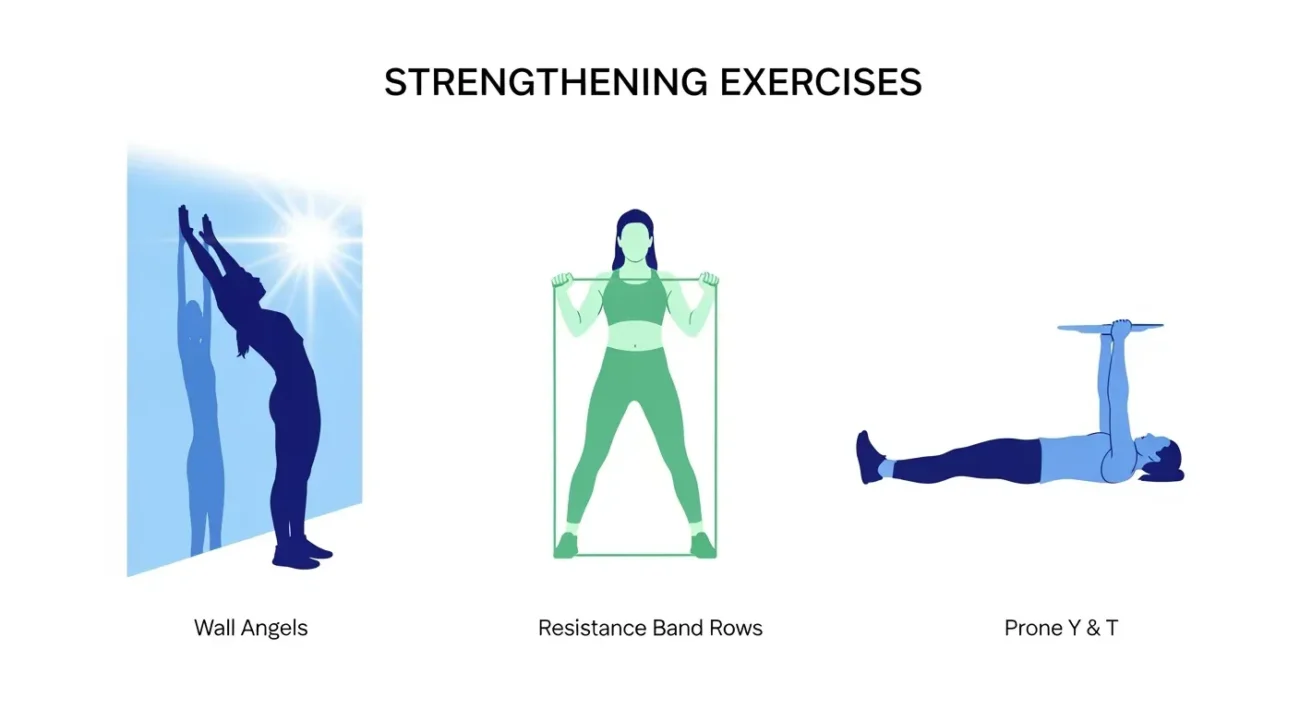If you’ve ever felt a stubborn ache under your shoulder blade, you know how distracting it can be. Maybe it started after a workout, or maybe you woke up with it one morning. Sometimes it’s a sharp stab, sometimes a dull throb. Either way, it makes sitting, sleeping, and even breathing a little uncomfortable.
The truth is, pain under the shoulder blade is more common than most people think. It can come from simple muscle strain, poor posture, or sometimes something more serious like a pinched nerve or referred pain from an organ. The good news, Most causes are not dangerous and can be managed with the right approach.
We’ll explore the main causes of pain under the shoulder blade, how to find relief, when to see a doctor, and practical steps to prevent it from coming back. Stick around to the end, where I’ll answer some frequently asked questions.
Understanding the Shoulder Blade
Before diving into causes, it helps to understand what’s going on back there. The shoulder blade (medical name: scapula) is a flat, triangular bone that sits on each side of your upper back. It connects your arms to your chest and works with muscles, tendons, and nerves to allow smooth movement.
The area under the shoulder blade is like a busy traffic intersection:
- Muscles: Rhomboids, trapezius, serratus anterior, and latissimus dorsi all attach near or under the scapula.
- Nerves: Many nerves run from your neck and spine into your shoulder and arm.
- Bones & Joints: Ribs, spinal vertebrae, and small facet joints support the area.
When any of these get irritated or injured, pain shows up under the blade.
Causes of pain under the shoulder blade:
| Cause | Description | Symptoms and details |
|---|---|---|
| Muscular strain or knots | Injury to the muscles supporting the shoulder blade, most often the rhomboids and trapezius. | • Dull ache or sharp pain between the spine and shoulder blade • Can result from poor posture, heavy lifting, or overuse • A muscle knot may feel tender to the touch |
| Poor posture | Weakens or overloads the muscles of the upper back and neck from prolonged slouching, desk work, or smartphone use. | • Tension, muscle imbalances, and pain • Contributes to rounded shoulders and a forward head posture |
| Spinal problems | Issues with the vertebrae or discs in the neck (cervical spine) or upper back (thoracic spine). | • Herniated or bulging disc: Can compress nerve roots, causing radiating pain. • Osteoarthritis: Wear-and-tear arthritis in the neck or upper back. • Spinal stenosis: Narrowing of the spinal canal. |
| Nerve impingement | Compression or irritation of a nerve, such as cervical radiculopathy, where a pinched nerve in the neck radiates pain to the shoulder blade. | • Pain, numbness, tingling, or weakness in the shoulder, arm, or hand. • Can also cause a visible protrusion of the shoulder blade (“winging”). |
| Referred pain from organs | Pain felt in the shoulder blade, but originating from an internal organ. | • Heart conditions: Including heart attack (often on the left side). • Gallbladder disease: Can cause sharp pain under the right shoulder blade. • Lung conditions: Conditions such as a pulmonary embolism or collapsed lung. • Digestive issues: Including acid reflux or stomach ulcers. |
| Other conditions | Systemic or localized issues that can present as shoulder blade pain. | • Snapping scapula syndrome: Muscles and bones around the shoulder blade rub together. • Fibromyalgia: A chronic condition causing widespread pain and tenderness. • Shingles: Can cause a burning pain and rash if the virus affects nerves in that area. • Injuries: Fractures of the scapula or a dislocated rib. |
Common Causes of Pain Under the Shoulder Blade
Muscle Strain or Overuse
This is the number one culprit. Maybe you lifted something heavy, did too many push ups, or worked at your desk all day without moving. The small stabilizing muscles around your shoulder blade can get tired, tight, and sore.
Poor Posture
Slouching at your desk, hunching over your phone, or carrying heavy bags on one shoulder puts uneven stress on the muscles. Over time, this leads to pain that feels like it’s coming from deep under the blade.
Myofascial Trigger Points
Ever felt a tender knot in your back? These are tight bands of muscle fibers that cause pain locally and sometimes send pain to other areas. Knots under the shoulder blade are common, especially in people who sit for long hours.
Disc or Spinal Issues
A herniated disc in your neck or upper back can pinch nearby nerves, creating pain under the scapula. This type of pain is often sharp, burning, or comes with tingling in the arm.
Arthritis or Joint Problems
Wear-and-tear in the small facet joints of the spine or inflammation in rib joints can cause referred pain under the blade.
Nerve Irritation
Nerves from the cervical (neck) and thoracic (upper back) spine travel under the shoulder blade. If they get compressed, you might feel stabbing, burning, or even numbness.
Referred Pain from Organs
Not every shoulder blade ache is musculoskeletal. Sometimes internal organs are to blame. For example:
- Gallbladder problems: Pain may show up under the right shoulder blade.
- Heart issues: A heart attack, especially in women, can cause pain under the left shoulder blade.
- Lung conditions: Infections, inflammation, or tumors can send pain signals to this area.
Stress & Emotional Tension
Believe it or not, stress can literally sit on your shoulders. When you’re anxious or tense, your upper back muscles tighten, which often leads to pain between or under the blades.
How to Tell if It’s Serious

Most shoulder blade pain is harmless and improves in days or weeks. But sometimes it signals something bigger. See a doctor if you notice:
- Sudden severe pain after injury or accident
- Pain with chest tightness, shortness of breath, or sweating
- Pain with fever, cough, or weight loss
- Tingling, numbness, or weakness in your arm
- Pain that doesn’t improve after a couple of weeks of home care
Relief: What Actually Helps
Rest But Not Too Much
Give your muscles a break from the activity that triggered the pain. But avoid lying in bed all day gentle movement helps blood flow and healing.
Ice and Heat Therapy
Ice helps in the first 48 hours (especially for fresh strain or swelling). Heat is better for long-term aches, knots, and stiffness. Alternate both if needed.
Over the Counter Medications
Ibuprofen or acetaminophen can ease pain and inflammation. Always follow directions and check with your doctor if you have other conditions.
Stretches That Work
Gentle stretches reduce tension and improve mobility:
- Shoulder Blade Squeeze: Sit upright, squeeze your shoulder blades together, hold for 5 seconds, repeat 10 times.
- Doorway Stretch: Place arms on a doorway, lean forward to open your chest.
- Neck Tilt: Gently tilt ear toward shoulder to stretch the side of your neck.
Strengthening Exercises

Weak muscles make pain return. Try:
- Wall Angels: Stand against a wall, move arms slowly up and down like making a snow angel.
- Resistance Band Rows: Pull band toward chest while squeezing shoulder blades.
- Prone Y & T: Lying on stomach, lift arms in Y and T shapes to target stabilizers.
Improve Posture
Adjust your desk setup: screen at eye level, feet flat on the floor, shoulders relaxed. Take breaks every 30–60 minutes to stretch and walk around.
Better Sleep Setup
Invest in a supportive mattress and pillow. Avoid sleeping on your stomach (twists the neck). Try side-sleeping with a pillow between your knees or back-sleeping with a small pillow under your pain behind knee.
Stress Management
Yoga, meditation, deep breathing, or even a walk outside can reduce muscle tension caused by stress.
FAQs
How long does it take for pain under the shoulder blade to heal?
Mild muscle strains can heal in a week or two with rest and home care. More serious causes like disc issues may take weeks to months and often need professional treatment.
Can shoulder blade pain mean a heart attack?
Yes. Especially left-sided pain with chest pressure, sweating, or nausea. Don’t ignore these signs call emergency services.
What’s the difference between muscle pain and nerve pain?
Muscle pain usually feels dull, achy, or sore. Nerve pain often feels sharp, burning, or electric, and may come with tingling or numbness.
Should I see a doctor right away?
If your pain is severe, sudden, or linked with other symptoms (breathing problems, fever, numbness, weakness), yes. Otherwise, try home care for a week or so.
Conclusion
Pain under the shoulder blade is common, but it’s not something you should just ignore. Most of the time it’s caused by muscle strain, poor posture, or everyday habits. With simple home remedies like stretching, strengthening, ice/heat, and posture fixes, you can get relief. But don’t forget sometimes it’s a sign of something more serious. If your pain lingers or comes with other worrying symptoms, get checked out. Your body is always giving you signals, and your shoulder blade might just be trying to get your attention.

